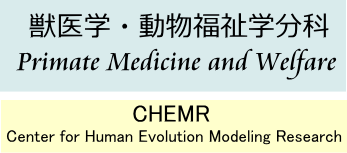





We conduct clinical research in collaboration with staff vets who take care of nonhuman primates when they are injured or suffer from various diseases. We have a lot of interesting cases and it is important that we report those cases as a case report and accumulate the knowledge of spontaneous diseases in nonhuman primates.
<chimpanzees>
・transverse myelitis
・arachnoid cysts
・degenerative joint disease
<Japanese macaques>
bloat
non alcoholic steatohepatitis
simian retro virus
hepatocellular carcinoma
Squamous cell carcinoma
Related study
oral health in chimpanzees
helicobacter infection in nonhuman primates



Animal Welfare is a concept that we minimize pain and distress in captive animals and improve their quality of life (QOL). It is important to assess their physical and psychological wellbeing using physiological, behavioral, and biological markers. We try to improve QOL of the captive nonhuman primates in KUPRI through environmental enrichment to meet behavioral requirement of the animals and behavioral management to minimize distress of restraint and anesthetic risks
Related study
Physiological study on stress
Feeding enrichment based on contra free loading
Study on positive reinforcement training






<To perform high quality anesthesia>
There are many situations that require anesthesia in research and management of nonhuman primates. Especially, some surgeries such as craniotomy in neuroscience research are invasive and requires long duration of anesthesia. From animal welfare point of view, high quality anesthesia is required to minimize pain and distress in nonhuman primates.
Intravenous anesthetic, propofol has high controllability and when used in combination with analgesics such as fentanyl, precise control of anesthetic depth and duration is possible based on pharmacokinetics and preferably used in neurosurgery in humans. We established population pharmacokinetics model of propofol in Japanese macaques and now working on the model in marmosets. We are also working on pharmacodynamic models using EEG monitors.


<How nonhuman primates express pain?>
Nonhuman primates tend to hide pain to survive in their group. Therefore, it is very difficult to assess pain in nonhuman primates. We try to assess their pain using the facial expression and behavior. We use the clinical cases and observe macaques in pain by injury or surgery. We try to avoid giving experimental pain to them.

Juri Suzuki, Associate Prof. DVM, PhD
suzuki.juri.4u@kyoto-u.ac.jp
Research: stress, growth, spontaneous diseases
Takako Miyabe Assistant Prof. DVM, PhD
miyabe.takako.2s@kyoto-u.ac.jp
Research: anesthesia, pain, spontaneous diseases


